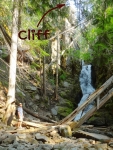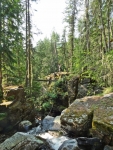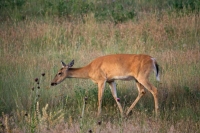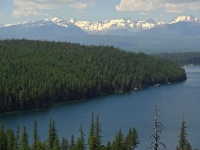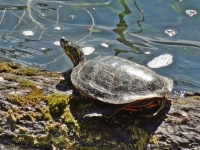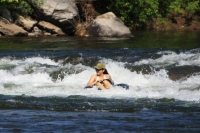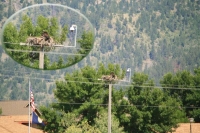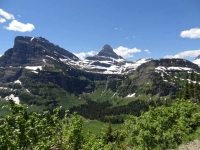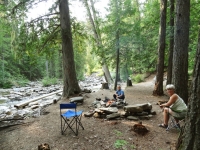 After our great week with Ari and Eric, it was time to hit the road again; this time for the full camping experience. We planned to meander north and west, eventually getting to Seattle before heading down the west coast through the redwoods.
After our great week with Ari and Eric, it was time to hit the road again; this time for the full camping experience. We planned to meander north and west, eventually getting to Seattle before heading down the west coast through the redwoods.
Monday when Eric headed back to work, Ari worked to organize and store all the wedding and reception supplies that had been quickly boxed for the trip from the ranch. Our time was spent doing laundry, packing, and reorganizing the car. We had temporarily cleared out our car and stored all our gear in the garage to make room for passengers during the wedding festivities. During our travels, the back seat was usually piled high with sleeping bags, two thermal mattresses (partially deflated), pillows, travel chairs, and the tent. On the floor in the back we carried 12 gallons of drinking water that we would refill at grocery stores. We were glad to have the extra water while camping.
 Off we drove Tuesday, July15, north on Highway 93 to Kootenai National Forest and stopped at the Rexford Eureka Ranger’s Station. The ranger was extremely helpful offering recommendations of camping and hiking options including a waterfall hike – always high on our list. We drove along the scenic steep cliffs of Lake Koocanusa, a 90 mile long lake that straddles the USA/Canadian border. Lake Koocanusa is named for the Kootenai River, Canada, and the USA. We crossed to the west side of the long narrow lake on the only bridge over the US half of the lake.
Off we drove Tuesday, July15, north on Highway 93 to Kootenai National Forest and stopped at the Rexford Eureka Ranger’s Station. The ranger was extremely helpful offering recommendations of camping and hiking options including a waterfall hike – always high on our list. We drove along the scenic steep cliffs of Lake Koocanusa, a 90 mile long lake that straddles the USA/Canadian border. Lake Koocanusa is named for the Kootenai River, Canada, and the USA. We crossed to the west side of the long narrow lake on the only bridge over the US half of the lake.  Once we reached the turn off for the waterfall hike, we drove a mile slowly along a dirt road. Here we found not only the trail head but also an amazing camp site by a clear bubbling stream with a great stone fire ring and dry wood. We enjoyed a fire both in the evening and the following morning. This is the first time we used our new camping stove and the camping chairs that mom packed for us. What a luxury to have warm seating and hot tea water. We loved the spot and the sound of the running stream all night.
Once we reached the turn off for the waterfall hike, we drove a mile slowly along a dirt road. Here we found not only the trail head but also an amazing camp site by a clear bubbling stream with a great stone fire ring and dry wood. We enjoyed a fire both in the evening and the following morning. This is the first time we used our new camping stove and the camping chairs that mom packed for us. What a luxury to have warm seating and hot tea water. We loved the spot and the sound of the running stream all night.
 In the morning, we prepared for a 6 miles round trip hike to Little North Fork Falls. Turns out the falls are only 1/2 mile back from the road on a well maintained nature trail! Along the trail were small interpretive signs describing the flora and geology. As we got farther back the trail, we began seeing a large amount of leaning and fallen trees. The splintered trees distracted from the beauty of the scenic location and we wondered why they were not cleared out near the trail. As we were asking the question, we came upon a set of interpretive signs that explained Course Woody Debris.
In the morning, we prepared for a 6 miles round trip hike to Little North Fork Falls. Turns out the falls are only 1/2 mile back from the road on a well maintained nature trail! Along the trail were small interpretive signs describing the flora and geology. As we got farther back the trail, we began seeing a large amount of leaning and fallen trees. The splintered trees distracted from the beauty of the scenic location and we wondered why they were not cleared out near the trail. As we were asking the question, we came upon a set of interpretive signs that explained Course Woody Debris.
 In a healthy temperate forest up to 30% of the woody biomass will consist of dead wood. The dead trees provide both food and habitat for many species of bacteria, fungi, lichens, mosses, small plants, which in turn support a rich diversity of species. Had we poked around we would have seen a wide variety of beetles, larvae, ants, and termites. Woody debris in the stream slows down the flow and creates small sediment-filled pools were we could have seen snails, salamanders, frogs, and aquatic insects. Several species of bird are dependent on dead trees for nesting sites. Scientists estimate that up to 40% of all forest fauna is dependent on woody debris.
In a healthy temperate forest up to 30% of the woody biomass will consist of dead wood. The dead trees provide both food and habitat for many species of bacteria, fungi, lichens, mosses, small plants, which in turn support a rich diversity of species. Had we poked around we would have seen a wide variety of beetles, larvae, ants, and termites. Woody debris in the stream slows down the flow and creates small sediment-filled pools were we could have seen snails, salamanders, frogs, and aquatic insects. Several species of bird are dependent on dead trees for nesting sites. Scientists estimate that up to 40% of all forest fauna is dependent on woody debris.
 We had mistakenly believed that the ash remaining from intermittent forest fires was sufficient to provide the carbon, nitrogen, phosphorus, and potassium needed for regrowth of a healthy forest. This is not the case. The woody debris itself is not particularly rich in nitrogen. But, during slow decomposition, the woody debris acts as host to free-living nitrogen-fixing bacteria which are essential to maintain healthy biodiversity in the ecosystem. Well, that and bear poop. Neil pointed out that the fallen trees attract bears who tear them open to get to the beetles and larvae and then deposit their nitrogen-rich fertilizer in the area. Do not underestimate the importance of bear poop.
We had mistakenly believed that the ash remaining from intermittent forest fires was sufficient to provide the carbon, nitrogen, phosphorus, and potassium needed for regrowth of a healthy forest. This is not the case. The woody debris itself is not particularly rich in nitrogen. But, during slow decomposition, the woody debris acts as host to free-living nitrogen-fixing bacteria which are essential to maintain healthy biodiversity in the ecosystem. Well, that and bear poop. Neil pointed out that the fallen trees attract bears who tear them open to get to the beetles and larvae and then deposit their nitrogen-rich fertilizer in the area. Do not underestimate the importance of bear poop.
 Crossing a bridge, we found ourselves at the base of an impressive waterfall coursing among jutting rocks from a dramatic height. Well worth the excursion! The forest service map showed the trail continuing on beyond the top of the falls but all we could see were layers of fallen logs. Neil started off to trail blaze while I waited at the top of the falls but he soon returned as it was very tough going (as I expected) and there seemed little to make it worth the effort. We returned to the campsite, took a refreshing, brrrrracing—read that as cold—swim in a swimming hole, packed our gear and headed on the road again. If we had known what was coming, we might have stayed a few more days by that delightful bubbling stream!
Crossing a bridge, we found ourselves at the base of an impressive waterfall coursing among jutting rocks from a dramatic height. Well worth the excursion! The forest service map showed the trail continuing on beyond the top of the falls but all we could see were layers of fallen logs. Neil started off to trail blaze while I waited at the top of the falls but he soon returned as it was very tough going (as I expected) and there seemed little to make it worth the effort. We returned to the campsite, took a refreshing, brrrrracing—read that as cold—swim in a swimming hole, packed our gear and headed on the road again. If we had known what was coming, we might have stayed a few more days by that delightful bubbling stream!
Photo Credit: Neil Rhoads and Nanette Harter
Photo Slider: A new addition to the website is the photo slider banner. For some posts such as this one, we have made a unique slider with pictures from this adventure only. If you are reading this in email be sure to check out the webpage so you can see the slider in action.
Photo gallery below:
Clicking on the first photo brings up a larger view with a description. Depending on your browser, you can use the arrow buttons or keys to move through the gallery photos. If you are receiving this in an email and don’t see a photo gallery below, please click into my webpage to view all the photos!





















